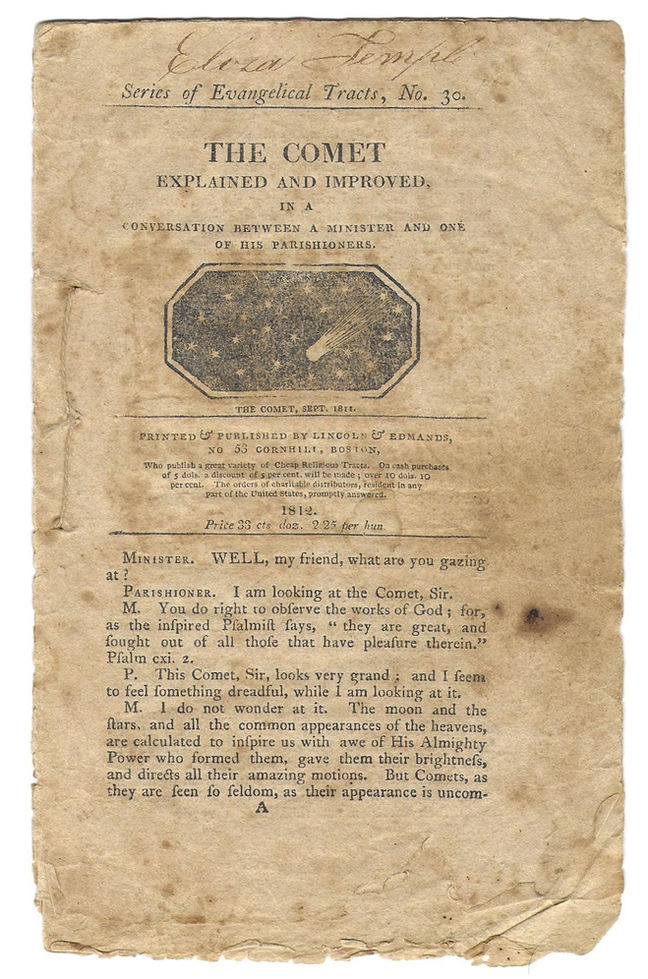Free international shipping over € 500
When the heavens blazed: a rare tract on the 1811 comet
€ 375,00
The Great Comet of 1811 shone for nine months, making it one of the most remarkable astronomical events in history, unmatched until Hale–Bopp in 1997.
Astronomers tracked it for a record-breaking 511 days, while across Europe and America, it captured the imagination of emperors, vintners, and ordinary citizens alike. Napoleon took it as a divine omen for his Russian campaign; winemakers hailed the year as one of the finest for vintages.
This scarce religious tract, printed in Boston by Lincoln and Edmands, captures how ordinary believers interpreted the comet’s appearance. Written as a dialogue, it stages a conversation between a fearful parishioner and a minister who urges him to fear God rather than celestial signs:
“Then when Comets shall blaze, when the elements shall melt with fervent heat … you will have a building of God, an house not made with hands, eternal in the heavens.” The tract concludes with a direct appeal to readers: “Believe in the Lord Jesus Christ and be saved.”
Lincoln and Edmands was a leading early 19th-century Boston publisher of Baptist tracts, and this edition is scarce. WorldCat records copies at the American Antiquarian Society and the Lilly Library, both with a press variant misnumbering page 12 as “21.” The present copy, by contrast, is corrected.
A rare survival of religious and cultural history sparked by one of the most famous comets ever seen.
Title
[Caption title:] Series of Evangelical Tracts, no. 30. The comet explained and improved in a conversation between a minister and one of his parishioners.
Boston, Lincoln and Edmands, 1812.
Physical Description
Ca. 19,4 x 12,2 cm. 12 pp. With a small woodcut showing the Great Comet of 1811. Side-stitched self wrappers. Untrimmed. Browned and foxed, the first two leaves with marginal defects, owner’s inscription of “Eliza Temple”.
References
Shaw, American bibliography 25126 & 26717; for the comet: Kronk, Cometography, volume 2, p. 19 ff.
Too good to miss
I certainly recommend Black Dog Rare Books to any librarian or collector
Nadav Sharon
Thomas Fisher Rare Book Library
Why collectors choose us
Well-researched
Listings include in-depth bibliographic and historical details.
Global Reach
We serve an international audience, catering to collectors worldwide.
Passion-Driven Expertise
The company is founded on a true love for books and historical artifacts.
Fast shipping
Orders are carefully packaged and promptly dispatched.
.png)








![Residentie-Renners-Club "Sparta", Kampioen van Nederland. Jubileumrit De Ronde van Den Haag. Den Haag, RRC Sparta, [1923].](https://static.wixstatic.com/media/3b7891_1d6881f8ed974180a332a55db79026fb~mv2.jpg/v1/fill/w_980,h_1432,al_c,q_85,usm_0.66_1.00_0.01,enc_avif,quality_auto/3b7891_1d6881f8ed974180a332a55db79026fb~mv2.jpg)
![Residentie-Renners-Club "Sparta", Kampioen van Nederland. Jubileumrit De Ronde van Den Haag. Den Haag, RRC Sparta, [1923].](https://static.wixstatic.com/media/3b7891_079ef6f1a88f46f98d9f2729e86ebf0c~mv2.jpg/v1/fill/w_980,h_1432,al_c,q_85,usm_0.66_1.00_0.01,enc_avif,quality_auto/3b7891_079ef6f1a88f46f98d9f2729e86ebf0c~mv2.jpg)
![Programma voor de windhondenrennen te houden op Zondag 5 Maart 1922. [The Hague], [G.W.R.], [1922]](https://static.wixstatic.com/media/3b7891_0f895e8d56f14bf0b0f5715bf5d5d715~mv2.jpg/v1/fill/w_980,h_1432,al_c,q_85,usm_0.66_1.00_0.01,enc_avif,quality_auto/3b7891_0f895e8d56f14bf0b0f5715bf5d5d715~mv2.jpg)
![Programma voor de windhondenrennen te houden op Zondag 5 Maart 1922. [The Hague], [G.W.R.], [1922]](https://static.wixstatic.com/media/3b7891_385cc0ea8b7e4c6ba998561bc865aabf~mv2.jpg/v1/fill/w_980,h_598,al_c,q_85,usm_0.66_1.00_0.01,enc_avif,quality_auto/3b7891_385cc0ea8b7e4c6ba998561bc865aabf~mv2.jpg)


![[Two Rabbis engrossed in a book]. [The Netherlands?], [early 20th century].](https://static.wixstatic.com/media/3b7891_e8fe1458d0ea4f33a6eadee1298b2ff5~mv2.jpg/v1/fill/w_980,h_809,al_c,q_85,usm_0.66_1.00_0.01,enc_avif,quality_auto/3b7891_e8fe1458d0ea4f33a6eadee1298b2ff5~mv2.jpg)
![[Two Rabbis engrossed in a book]. [The Netherlands?], [early 20th century].](https://static.wixstatic.com/media/3b7891_8be9da7f965548e0a8f1cd14be192128~mv2.jpg/v1/fill/w_980,h_809,al_c,q_85,usm_0.66_1.00_0.01,enc_avif,quality_auto/3b7891_8be9da7f965548e0a8f1cd14be192128~mv2.jpg)




![Solidarität mit Erez Israel! Berlin, Die Landeskommission des Keren Kajemeth Lejisrael für Deutschalnd, [1930s].](https://static.wixstatic.com/media/3b7891_10be88b749a84879b68e5b6a690c86d3~mv2.jpg/v1/fill/w_980,h_1350,al_c,q_85,usm_0.66_1.00_0.01,enc_avif,quality_auto/3b7891_10be88b749a84879b68e5b6a690c86d3~mv2.jpg)
![Solidarität mit Erez Israel! Berlin, Die Landeskommission des Keren Kajemeth Lejisrael für Deutschalnd, [1930s].](https://static.wixstatic.com/media/3b7891_9edc7486d2d1409cbb928923db0c7343~mv2.jpg/v1/fill/w_980,h_1350,al_c,q_85,usm_0.66_1.00_0.01,enc_avif,quality_auto/3b7891_9edc7486d2d1409cbb928923db0c7343~mv2.jpg)


![Meier Salomon Bromet. Mijn bibliotheek No. 14. Het bordje kersen. Amsterdam, M.S. Bromet, [1872-1876].](https://static.wixstatic.com/media/3b7891_348551f1faa8419fa73c979a74d491ec~mv2.jpg/v1/fill/w_980,h_1306,al_c,q_85,usm_0.66_1.00_0.01,enc_avif,quality_auto/3b7891_348551f1faa8419fa73c979a74d491ec~mv2.jpg)
![Meier Salomon Bromet. Mijn bibliotheek No. 14. Het bordje kersen. Amsterdam, M.S. Bromet, [1872-1876].](https://static.wixstatic.com/media/3b7891_538fae04d54d405bb0c13de9bbadddd4~mv2.jpg/v1/fill/w_980,h_735,al_c,q_85,usm_0.66_1.00_0.01,enc_avif,quality_auto/3b7891_538fae04d54d405bb0c13de9bbadddd4~mv2.jpg)




![Henk Rolsma. Neuengamme. De ramp in de bocht van Lübeck. Groningen, [H.v.d. Woude Jr], [1945].](https://static.wixstatic.com/media/3b7891_daeece3ad6a244f4abf40b0838f8b12f~mv2.jpg/v1/fill/w_980,h_1329,al_c,q_85,usm_0.66_1.00_0.01,enc_avif,quality_auto/3b7891_daeece3ad6a244f4abf40b0838f8b12f~mv2.jpg)
![Henk Rolsma. Neuengamme. De ramp in de bocht van Lübeck. Groningen, [H.v.d. Woude Jr], [1945].](https://static.wixstatic.com/media/3b7891_2695153e2c1e4f50b84b0ea863199ff6~mv2.jpg/v1/fill/w_980,h_1329,al_c,q_85,usm_0.66_1.00_0.01,enc_avif,quality_auto/3b7891_2695153e2c1e4f50b84b0ea863199ff6~mv2.jpg)


![II. Zionisten-Congress in Basel. Journalisten-Karte. [Basel], [1898].](https://static.wixstatic.com/media/3b7891_2905fb42cba44dfb99432045492d3e8e~mv2.jpg/v1/fill/w_980,h_674,al_c,q_85,usm_0.66_1.00_0.01,enc_avif,quality_auto/3b7891_2905fb42cba44dfb99432045492d3e8e~mv2.jpg)
![II. Zionisten-Congress in Basel. Journalisten-Karte. [Basel], [1898].](https://static.wixstatic.com/media/3b7891_e1de5cae6caa4e529b6d9f62cdbe7278~mv2.jpg/v1/fill/w_980,h_674,al_c,q_85,usm_0.66_1.00_0.01,enc_avif,quality_auto/3b7891_e1de5cae6caa4e529b6d9f62cdbe7278~mv2.jpg)